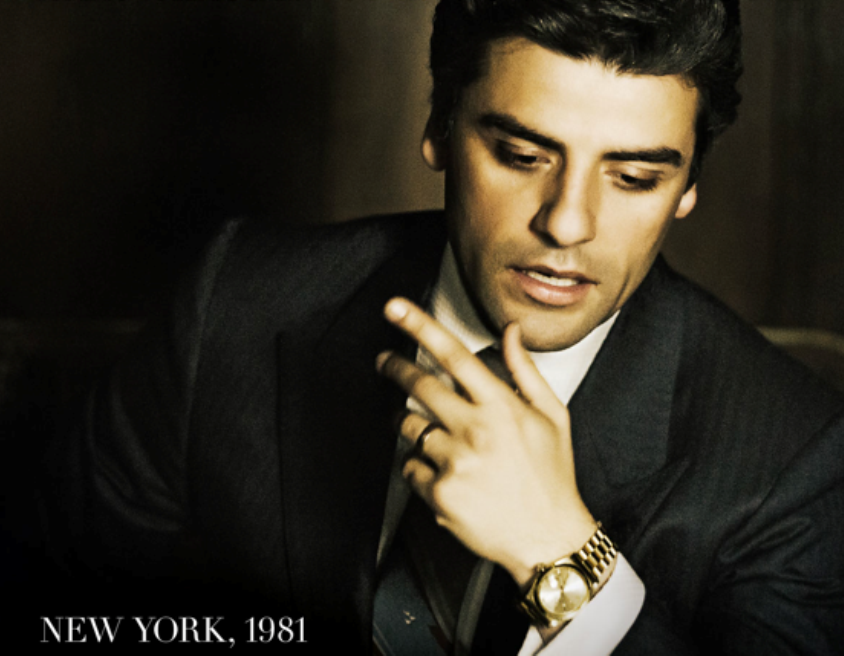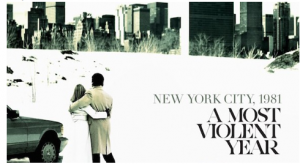Translating deep thinking into common sense
A Most Violent Year

By Kurt Keefner
February 10, 2015
SUBSCRIBE TO SAVVY STREET (It's Free)
The year of the title is 1981, when street crime in New York City was at its highest and political and business corruption was common. A Most Violent Year (2014) is the story of a principled businessman trying to stay clean in a dirty environment.
The man is Abel Morales (played by Oscar Isaac from Agora). The question is whether he is a man of able morals or whether he is Abel, the first murder victim. He runs a medium-sized home heating oil business. The main plot concerns his attempt to move up to the big leagues by buying several large riverside oil tanks and a dock. This is an ambitious and visionary move on his part, as it will allow him to buy fuel in the summer when it is cheap and sell it in the winter when it’s expensive.
A Most Violent Year is a three-dimensional portrait of a businessman.
During the film he is set upon by a swarm of troubles: 1. He places a non-refundable down payment on the property and has to come up with the balance in 30 days. This wouldn’t be a problem except for 2. Two hijackers are stealing his trucks for the oil they contain. One of his drivers gets hurt and Abel looks weak. 3. His business is under investigation (along with the rest of the industry, it seems) for unethical business practices. Abel may be facing prison time and his bank has lost faith in him.
The viewer is often left to ponder whether Abel is ethical or not. He says he is and takes great pride in it. Even the Mafia respect him. But I think one of the themes of the film is that it is impossible to stay perfectly clean in a corrupt world. This is brought into focus by Abel’s marriage to a Mafia princess, Anna, who has been cooking the books slightly.
Played by Jessica Chastain from Zero Dark Thirty, Anna is a tough cookie, pragmatic in both the good and the bad senses. At one point she tries to take credit for the business’ success, but it is clear that Abel’s drive, decency, and vision are mostly responsible for what he has achieved. At the end he does do something that is unqualifiedly corrupt, but it seems like a justifiable response to extortion. Ah, life in the big city!
 A large subplot of the film concerns the hijackings. The local Teamsters boss wants to arm the drivers, saying that he can get them carry-permits that will stand up in court if the drivers only shoot in self-defense. This is clearly shady on the boss’s part and Abel is very much opposed to it. He is not a man of violence and he seems to believe that armed drivers would create too much of a ‘wild west’ situation, a suspicion which is vindicated by the story. But can Abel himself be forceful in defending his empire? That’s a good question and you’ll have to watch the movie to get the answer.
A large subplot of the film concerns the hijackings. The local Teamsters boss wants to arm the drivers, saying that he can get them carry-permits that will stand up in court if the drivers only shoot in self-defense. This is clearly shady on the boss’s part and Abel is very much opposed to it. He is not a man of violence and he seems to believe that armed drivers would create too much of a ‘wild west’ situation, a suspicion which is vindicated by the story. But can Abel himself be forceful in defending his empire? That’s a good question and you’ll have to watch the movie to get the answer.
One of the best ways to make a positive character interesting is to give him “the defect of his virtues,” meaning that a good characteristic, if not seen in context or limited properly, can lead to bad consequences, as for example, when Howard Roark designs Peter Keating’s buildings for him in The Fountainhead. In A Most Violent Year, Abel has the defect of his strength of purpose. He thinks everyone else should be just as strong and he places people who are weaker in dangerous situations. He’s not using people—he just thinks everyone is, or could be, like himself.
The film is not Naturalism, because everything turns on the characters’ choices. Abel in particular is a real self-made man in every sense. But the film is shot in a naturalistic style, much like something out of the 1970s (or maybe 1981?). It’s gritty with “natural” sound recording. One reviewer compared it to an early film by Martin Scorcese, and this is right as far as it goes, except that Scorcese never had heroic businessmen in his movies. The style of the film makes sense because it is not only the portrait of a man, but also of a time and place.
 The contrast between Abel and his background is striking. Oscar Isaac is a beautiful man and Abel is always elegantly (and tastefully) dressed. Although we see a lot of dusty, dirty places during the film, the story ends with the skyline of Manhattan in the background, and I think we are supposed to take that as symbolic.
The contrast between Abel and his background is striking. Oscar Isaac is a beautiful man and Abel is always elegantly (and tastefully) dressed. Although we see a lot of dusty, dirty places during the film, the story ends with the skyline of Manhattan in the background, and I think we are supposed to take that as symbolic.
What I like about A Most Violent Year is that it is a three-dimensional portrait of a businessman. Abel is not the altruistic banker of It’s a Wonderful Life. He sees things and people as factors of production, as a good businessman does. He is not exploitative and he is very positive with his employees (there’s that defect again), but it is clear that he has a purpose and will not be stopped in realizing it.
Chandor (the film’s director) doesn’t take sides. He shows you a businessman dealing with a tough situation and you have to decide for yourself what you think of him.
Like director J.C. Chandor’s earlier movie, Margin Call, this film is what you might call a “business procedural.” (Another, classic example of this genre would be Executive Suite.) But most of the characters in Margin Call were morally compromised in a way that Abel is not, and so A Most Violent Year is ultimately more satisfying. I like it, however, that Chandor doesn’t take sides. He shows you a businessman dealing with a tough situation and you have to decide for yourself what you think of him. Just remember when you do that somebody has to deliver the heating oil and that Abel is not responsible for living in a most violent year. But he has to deal with it.








